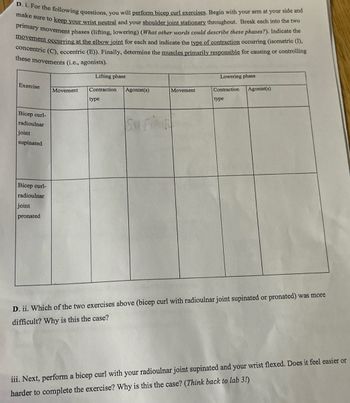
Human Anatomy & Physiology (11th Edition)
11th Edition
ISBN: 9780134580999
Author: Elaine N. Marieb, Katja N. Hoehn
Publisher: PEARSON
expand_more
expand_more
format_list_bulleted
Question
thumb_up100%

Transcribed Image Text:D. i. For the following questions, you will perform bicep curl exercises. Begin with your arm at your side and
make sure to keep your wrist neutral and your shoulder joint stationary throughout. Break each into the two
primary movement phases (lifting, lowering) (What other words could describe these phases?). Indicate the
movement occurring at the elbow joint for each and indicate the type of contraction occurring (isometric (I),
concentric (C), eccentric (E)). Finally, determine the muscles primarily responsible for causing or controlling
these movements (i.e., agonists).
Exercise
Bicep curl-
radioulnar
joint
supinated
Bicep curl-
radioulnar
joint
pronated
Lifting phase
Movement Contraction
type
Agonist(s)
Su
Movement
Lowering phase
Contraction
type
Agonist(s)
D. ii. Which of the two exercises above (bicep curl with radioulnar joint supinated or pronated) was more
difficult? Why is this the case?
iii. Next, perform a bicep curl with your radioulnar joint supinated and your wrist flexed. Does it feel easier or
harder to complete the exercise? Why is this the case? (Think back to lab 3!)
Expert Solution
This question has been solved!
Explore an expertly crafted, step-by-step solution for a thorough understanding of key concepts.
This is a popular solution
Trending nowThis is a popular solution!
Step by stepSolved in 5 steps

Knowledge Booster
Similar questions
- MUSCULOSKELETAL ANA THIRD EDITIO Antagonistic muscle action chart. Cervical and lumbar spine Complete the chart by listing the muscle(s) or parts of muscles that are antagonist in their actions to the muscles in the left column. Antagonist Agonist Splenius capitis Splenius cervicis Sternocleidomastoid Erector spinae Rectus abdominis External oblique abdominal Internal oblique abdominal Quadratus lumborum iticarrow_forwardDescribe a physical movement such as sitting, throwing, kicking, stepping up, lifting a coffee cup, etc. Describe the specific muscles involved in this movement using the correct anatomical names. State the type of movement (flexion, extension, and rotation for example) for each muscle that you identify as involved in the movement.arrow_forwardDuring a Physical Education class, you ask your students to perform a standing vertical jump. Identify the type of muscle contraction involved in the jump and describe the movement patterns of the concentric and eccentric phases. Outline the agonists, antagonists and synergist muscles, which contribute to maximum jump height. Identify the major lower body joints and joint movements, which contribute to the concentric phase of the jump.arrow_forward
- Describe an injury of the knee or hip. What muscle group(s) would be important to target in the rehabilitation process? Why?arrow_forwardPlease help label the followingarrow_forwardDescribe each of the below muscle actions and list at least one muscle that creates the action.Lower Extremity Muscle Actions: · Knee flexion · Knee extension · Knee medial rotation · Knee lateral rotation · Dorsiflexion · Plantarflexion · Foot inversion · Foot eversion · Foot digits flexion · Foot digits extension· Hip flexion · Hip extension · Hip medial rotation · Hip lateral rotation · Hip abduction · Hip adductionarrow_forward
- A patient demonstrates 0 (absent) DTR of the right triceps brachii, paresthesia over the right third digit and 3/5 strength during resisted elbow extension and wrist flexion testing. What is the most likely diagnosis? What are common types of treatment for this condition?arrow_forwardPoor  posture Assume that your client, Phil, age 55, has come to work out with your facility with poor posture. Now - prescribe a few specific stretching and strengthening exercises for this particular area of concern in addition to some aerobic exercise. Assume your client has been cleared for exercise. 1. State the problem your client has. What will this mean as far as special considerations (what sets this apart from the typical exercise prescription) when Phil exercises? 2. State what stretches and/or strengthening/Resistance exercises you will use. Please attach images and state what the name of the exercise is and what it is supposed to stretch/strengthen related to the procedure, or the condition Phil has.arrow_forwardTo do Right shoulder abduction – A24 in the frontal plane, the (muscle) would have to lie (A – Where?) relative to the joint, and since it can only (B ), the fibers would have to run (C ) to the (D ) axis to achieve the desired movement. choose from: A. Pick from: Anterior, Posterior, Medial, Lateral, Superior, Inferior B. Write in the word “PULL” C. Write “perpendicular” D. Pick from :Anterior - posterior, Superior-inferior or Medio - Lateralarrow_forward
arrow_back_ios
arrow_forward_ios
Recommended textbooks for you
 Human Anatomy & Physiology (11th Edition)Anatomy and PhysiologyISBN:9780134580999Author:Elaine N. Marieb, Katja N. HoehnPublisher:PEARSON
Human Anatomy & Physiology (11th Edition)Anatomy and PhysiologyISBN:9780134580999Author:Elaine N. Marieb, Katja N. HoehnPublisher:PEARSON Anatomy & PhysiologyAnatomy and PhysiologyISBN:9781259398629Author:McKinley, Michael P., O'loughlin, Valerie Dean, Bidle, Theresa StouterPublisher:Mcgraw Hill Education,
Anatomy & PhysiologyAnatomy and PhysiologyISBN:9781259398629Author:McKinley, Michael P., O'loughlin, Valerie Dean, Bidle, Theresa StouterPublisher:Mcgraw Hill Education, Human AnatomyAnatomy and PhysiologyISBN:9780135168059Author:Marieb, Elaine Nicpon, Brady, Patricia, Mallatt, JonPublisher:Pearson Education, Inc.,
Human AnatomyAnatomy and PhysiologyISBN:9780135168059Author:Marieb, Elaine Nicpon, Brady, Patricia, Mallatt, JonPublisher:Pearson Education, Inc., Anatomy & Physiology: An Integrative ApproachAnatomy and PhysiologyISBN:9780078024283Author:Michael McKinley Dr., Valerie O'Loughlin, Theresa BidlePublisher:McGraw-Hill Education
Anatomy & Physiology: An Integrative ApproachAnatomy and PhysiologyISBN:9780078024283Author:Michael McKinley Dr., Valerie O'Loughlin, Theresa BidlePublisher:McGraw-Hill Education Human Anatomy & Physiology (Marieb, Human Anatomy...Anatomy and PhysiologyISBN:9780321927040Author:Elaine N. Marieb, Katja HoehnPublisher:PEARSON
Human Anatomy & Physiology (Marieb, Human Anatomy...Anatomy and PhysiologyISBN:9780321927040Author:Elaine N. Marieb, Katja HoehnPublisher:PEARSON

Human Anatomy & Physiology (11th Edition)
Anatomy and Physiology
ISBN:9780134580999
Author:Elaine N. Marieb, Katja N. Hoehn
Publisher:PEARSON

Anatomy & Physiology
Anatomy and Physiology
ISBN:9781259398629
Author:McKinley, Michael P., O'loughlin, Valerie Dean, Bidle, Theresa Stouter
Publisher:Mcgraw Hill Education,

Human Anatomy
Anatomy and Physiology
ISBN:9780135168059
Author:Marieb, Elaine Nicpon, Brady, Patricia, Mallatt, Jon
Publisher:Pearson Education, Inc.,

Anatomy & Physiology: An Integrative Approach
Anatomy and Physiology
ISBN:9780078024283
Author:Michael McKinley Dr., Valerie O'Loughlin, Theresa Bidle
Publisher:McGraw-Hill Education

Human Anatomy & Physiology (Marieb, Human Anatomy...
Anatomy and Physiology
ISBN:9780321927040
Author:Elaine N. Marieb, Katja Hoehn
Publisher:PEARSON